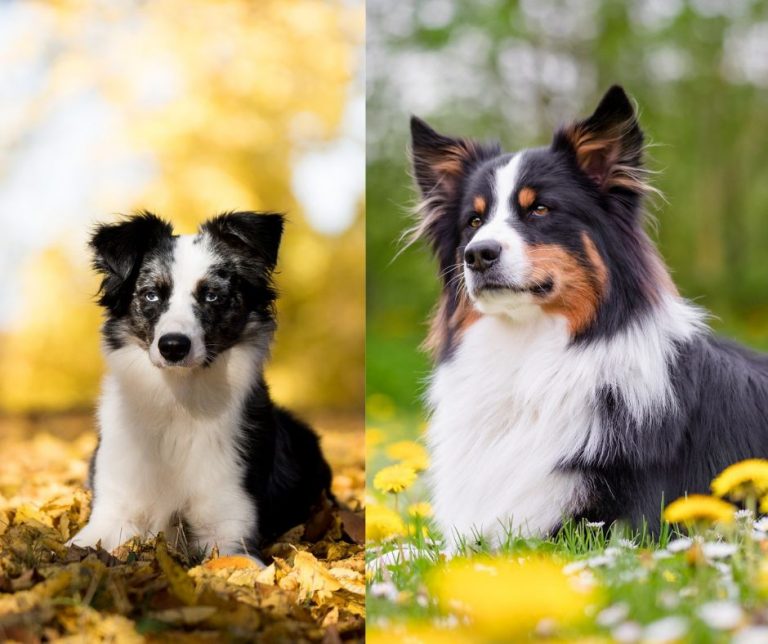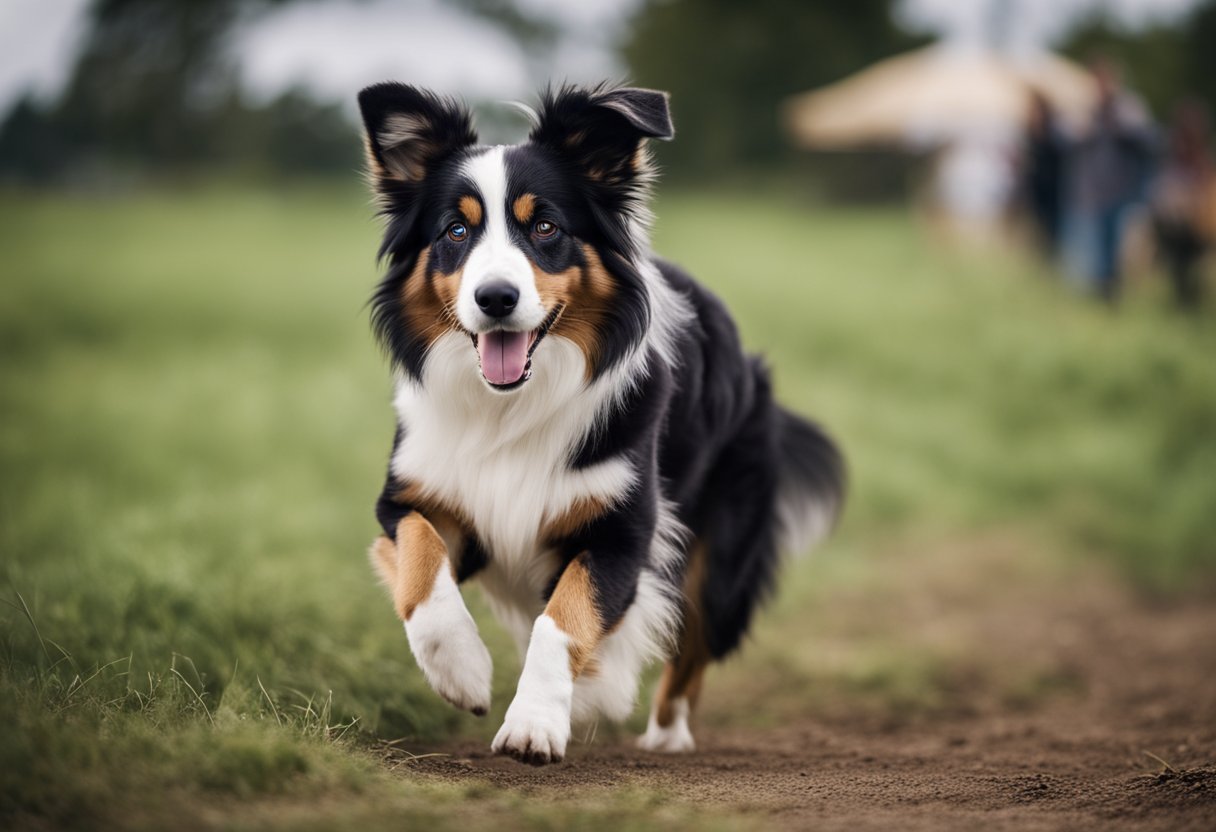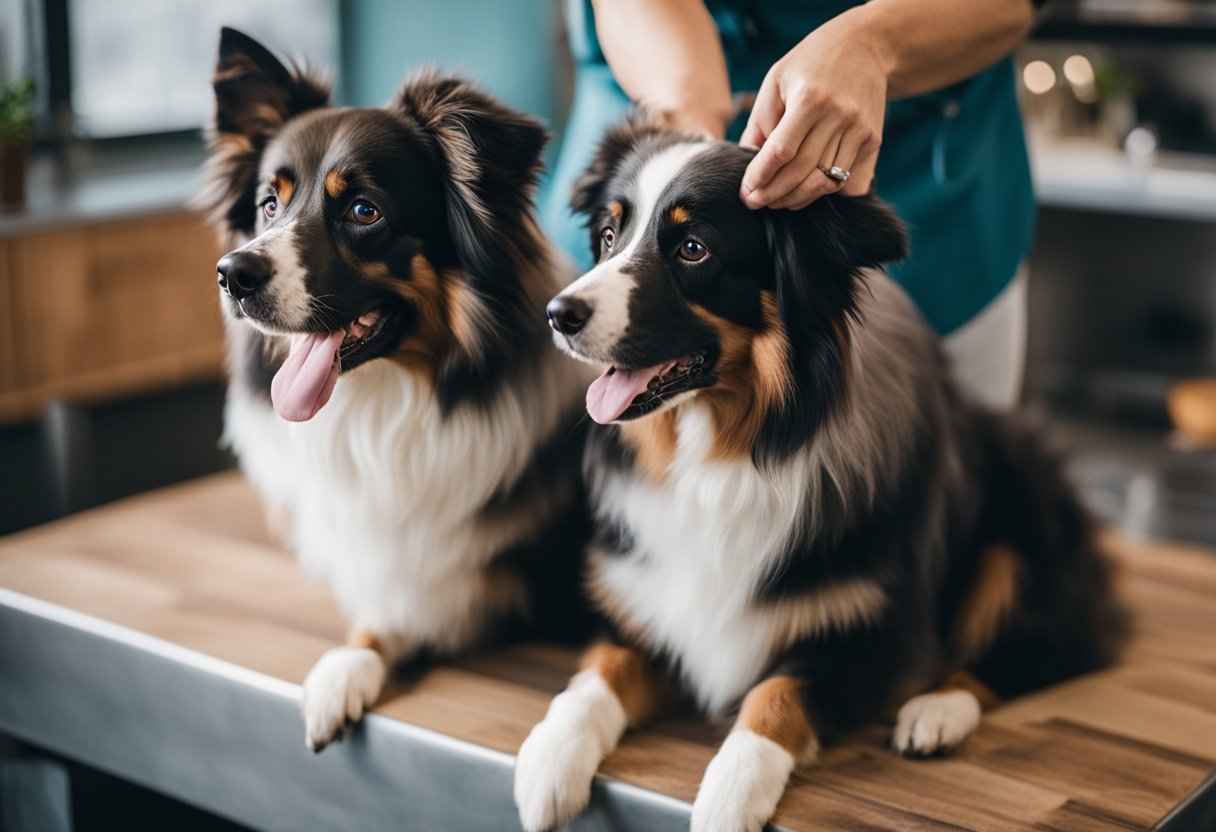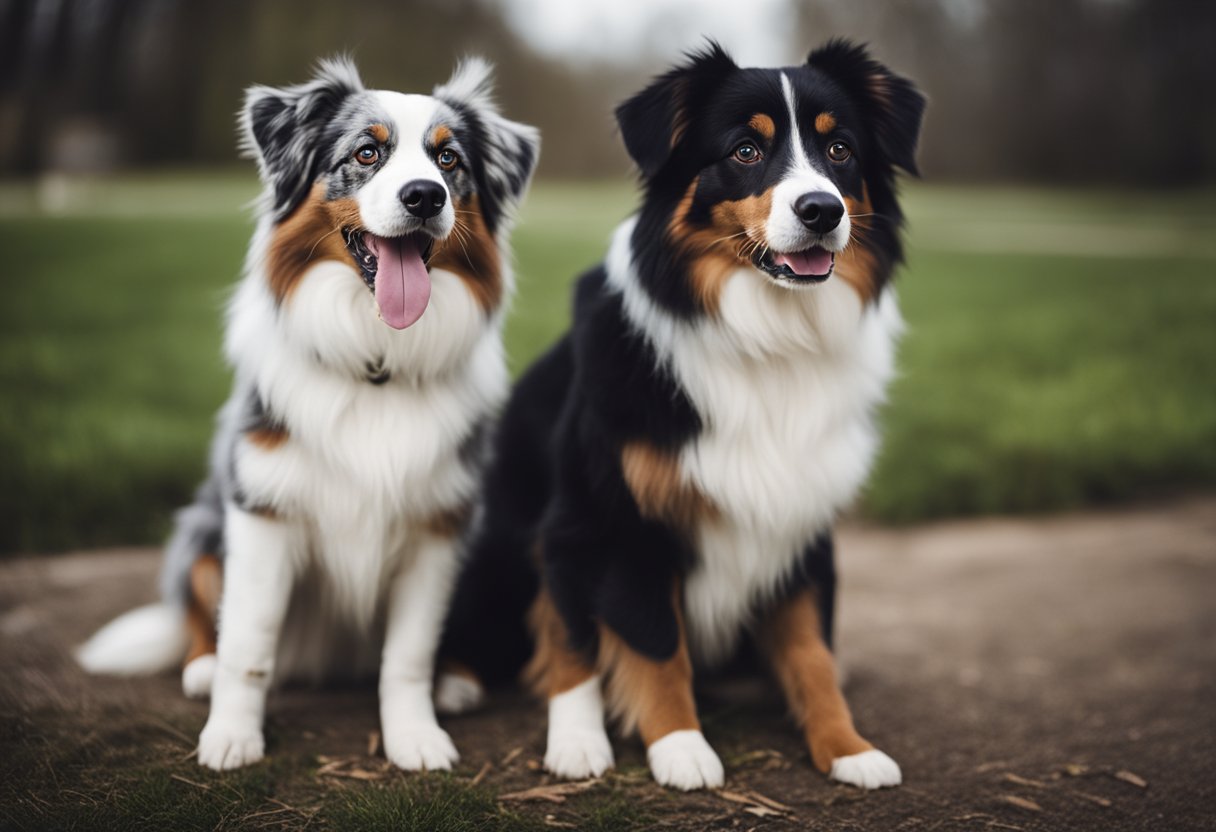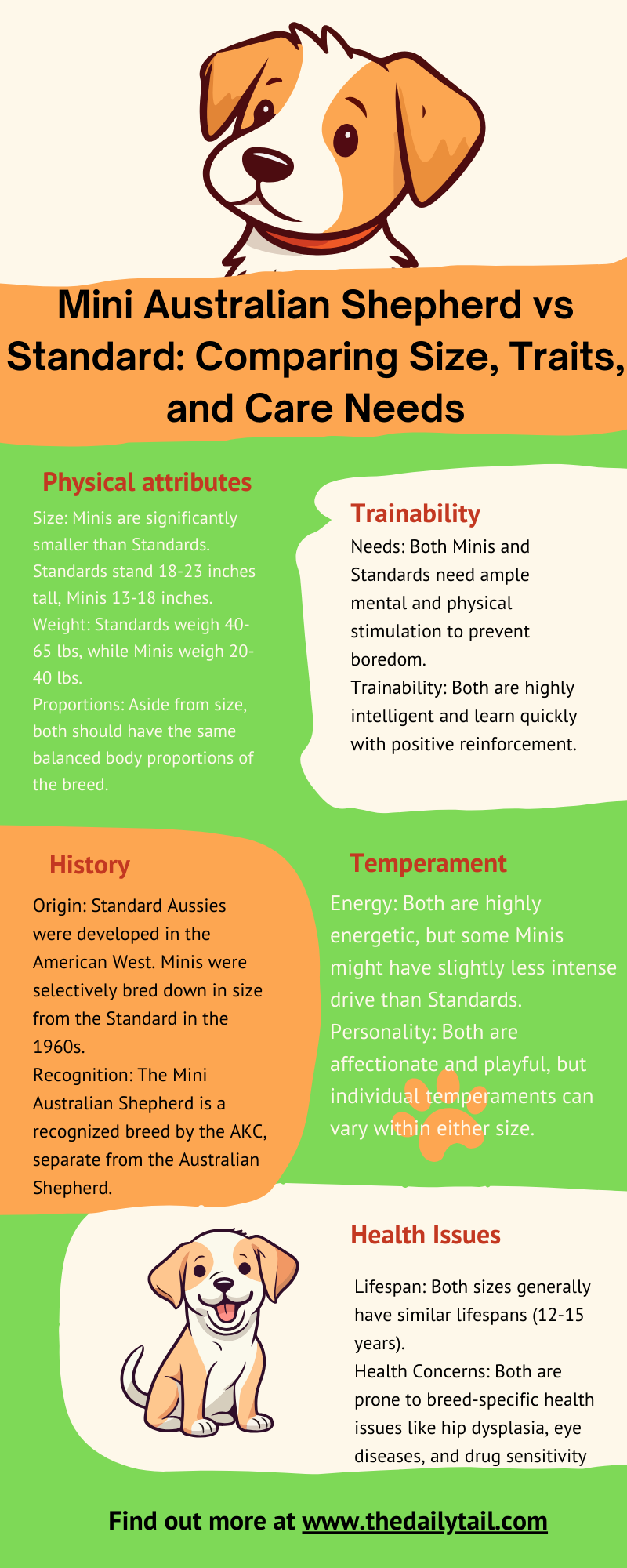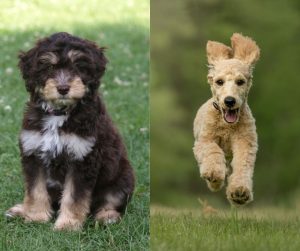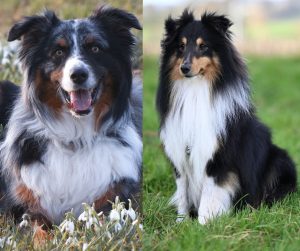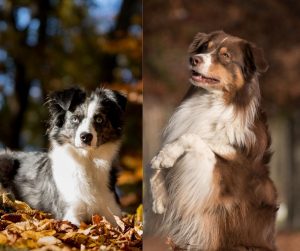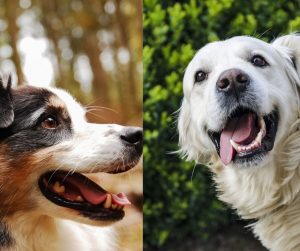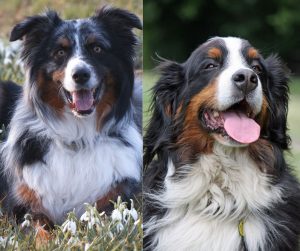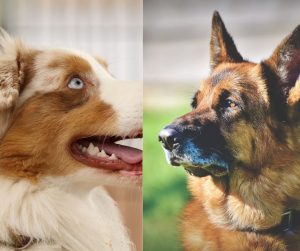Australian Shepherds are herding dogs with a rich history of work and companionship. This breed comes in three main sizes: standard, miniature, and toy. The standard and miniature varieties share many traits, such as their intelligence, energy, and herding instincts, yet they differ significantly in size and sometimes in lifestyle compatibility.
The Standard Australian Shepherd typically stands between 18-23 inches tall at the shoulder and weighs between 40-65 pounds, with males being larger than females. These dogs are known for their agility, training responsiveness, and a lifespan that averages 12-15 years. They require ample exercise and mental stimulation due to their working dog heritage.
In contrast, the Miniature Australian Shepherd possesses a similar appearance and personality but in a smaller package. Standing 14-18 inches tall, with no individuals standing less than 12 inches to avoid confusion with the toy variety, both male and female miniatures provide a more compact option for those seeking the Australian Shepherd’s characteristics in a smaller size.
Their weight ranges from 20 to 40 pounds, making them suitable for various living situations including those with limited space. These dogs maintain the breed’s energy and work ethic, requiring exercise and engaging activities to thrive.
As a seasoned dog owner, I know choosing between Mini and Standard Aussies goes beyond height and weight. Let’s dive into the key distinctions.
Breed Overview
In comparing Mini Australian Shepherds and Standard Australian Shepherds, one should consider their distinct histories, breed standards, physical characteristics, and health aspects. These factors are critical to understanding the nuances between the two variations of this intelligent and active herding breed.
Origins of Mini and Standard Australian Shepherds
Mini Aussies and Standard Australian Shepherds both trace their lineage back to the Basque region of Spain and France, where they were bred as herding dogs. Despite their name, their history begins with the Basque shepherds who emigrated to Australia, then to the United States, bringing their dogs along which they bred with other herding breeds across these regions. Over time, the breed became known for its work in the American West, and the name “Australian Shepherd” was adopted.
The Mini Australian Shepherd was developed in the 1960s when breeders sought to produce a smaller version of the Standard Australian Shepherd, leading to the breed that is now recognized as the Miniature American Shepherd by the American Kennel Club (AKC).
Recognized Standards and Variations
Both variations of the Australian Shepherd are recognized by various breed registries, but they have differences in their classifications Here is the dog breed standard set by the American Kennel Club:
- Standard Australian Shepherds are recognized by the AKC and are classified as herding dogs.
- Mini Australian Shepherds are recognized by the AKC under the name Miniature American Shepherd and by the American Stock Dog Registry (ASDR) as a separate breed.
Physical Characteristics
The key physical differences between the Mini and Standard Australian Shepherds are in size and weight:
| Mini Australian Shepherd | Standard Australian Shepherd | |
|---|---|---|
| Height (males) | 14-18 inches | 20-23 inches |
| Height (females) | 13-17 inches | 18-21 inches |
| Weight (males) | 20-40 lbs | 50-65 lbs |
| Weight (females) | 20-40 lbs | 40-55 lbs |
They share similar coat colors, including Merle, Black, Red Merle, Red tricolor, Black tricolor, Blue Merle, and Red, with a medium-length, water-resistant double coat.
Key Health Considerations
Both Mini and Standard Australian Shepherds are generally healthy, with a life expectancy of 12-15 years. However, due to genetics, they can be predisposed to certain health problems, which may include hip dysplasia, epilepsy, and certain eye disorders. Proactive health checks and responsible breeding practices can mitigate some of these risks. Regular exercise, a balanced diet, and routine veterinary care are essential for maintaining their health.
Temperament and Behavior
The temperament and behavior of the Australian Shepherd, whether mini or standard, revolve around their energetic nature, intelligence, and loyal disposition. They require substantial mental stimulation and display a protective nature.
Personality Traits
Australian Shepherds, both Mini and Standard, are recognized for their devotion and loyalty to their families. They are intelligent dogs who thrive on engaging activities and tasks. Here are some of their core traits:
- Active: They have high energy levels, necessitating regular exercise and involvement in activities
- Protective: This breed often shows a natural protective instinct, making them attentive guardians
- Affectionate: Australian Shepherds form strong bonds and are known for their affection towards their owners
Comparing Mini and Standard Aussie Temperaments
Mini Australian Shepherds and Standard Australian Shepherds share many temperament traits as they both have a herding instinct and are energetic and loyal. However, their differences in size may influence their suitability as a family dog, particularly in homes with limited space or smaller pets.
- Energy Levels: Both are high-energy, but Minis may adapt better to smaller living spaces as long as they receive adequate exercise
- Intelligence: They are equally intelligent, requiring regular mental stimulation to prevent boredom
- Herding Instinct: Both may exhibit herding behaviors, though the standard size might be more inclined to herd due to its larger size and strength
- Protective Instinct: Standards might have a more pronounced protective instinct due to their larger size
- Family Dog: Minis can be a better option for families with less room, while Standards may suit a more active lifestyle with ample space
Australian Shepherds, irrespective of size, thrive in environments where they can exercise both their bodies and minds. They are well-suited to active individuals or families who can cater to their high-spirited temperament.
Care and Management
When considering a Mini Aussie or Standard Australian Shepherd, one needs to understand their specific care needs in terms of exercise, grooming, and socialization. Both breeds embody high-energy levels and intelligence, demanding regular engagement through physical and mental activities.
Exercise Needs
Both Mini and Standard Australian Shepherds require significant daily exercise to maintain their health and happiness. They thrive on being active and will need a minimum of one to two hours of exercise daily. This should include activities like:
- Running: Works exceptionally for both breeds due to their herding instincts and energy levels
- Mental Stimulation: Puzzle toys and training activities to keep their minds sharp and engaged
Grooming and Maintenance
Grooming is vital regardless of the size of the Australian Shepherd. Their thick double coats require regular brushing, especially during shedding seasons. The care routine consists of:
- Brushing: A few times a week to avoid tangles and matting; more often during peak shedding
- Grooming: Basic grooming includes baths when necessary, trimming nails, and cleaning ears
Training and Socialization
Given their intelligence and eagerness to please, both Mini and Standard Australian Shepherds show high trainability. Training should begin early to ensure well-mannered adults and include:
- Attention to Commands: Routine training sessions are crucial for mental stimulation and reinforcing obedience
- Social Skills: Exposing them to various environments, people, and other dogs helps develop a sociable and adaptable temperament
Lifestyle Compatibility
When considering a Mini Australian Shepherd vs Standard Aussie Shepherd, lifestyle compatibility is a crucial aspect. Here’s a breakdown for potential owners:
Space Considerations:
- Mini Australian Shepherds
- Suitable for apartment living due to smaller size
- Need daily exercise, but less space for active play
- Standard Australian Shepherds
- Thrive with more room, preferably a house with a backyard
- Ideal for ranchers or those with open spaces
Energy Levels and Exercise:
- Both breeds are high-energy and require regular, vigorous exercise
- They excel in activities like agility, herding trials, and obedience
Family and Children:
- Mini and Standard Australian Shepherds are both good family dogs, known for their loyalty
- They have a strong herding instinct; supervision with young children is recommended to manage herding behavior
Time and Attention:
- These herding dogs crave human interaction and can become destructive if bored or lonely
- Owners must dedicate time for training, exercise, and companionship
Urban vs. Rural:
- Urban dwellers might prefer Mini Australian Shepherds for their adaptability to smaller living spaces
- Standard Australian Shepherds often fit better in rural settings where they can utilize their herding skills
Both Mini and Standard Australian Shepherds make engaging and interactive companions, depending on an owner’s living situation, time commitment, and ability to provide both physical and mental stimulation.
Acquisition and Adoption
When considering adding a Miniature Australian Shepherd or Standard Australian Shepherd to one’s life, the potential owner must make informed choices about whether to approach a breeder or a rescue, and understand the various cost factors involved.
Choosing a Breeder or Rescue
When seeking to acquire a Miniature or Standard Australian Shepherd, prospective owners can choose between reputable breeders or animal rescues. Breeders should provide clear health histories and be registered with recognized bodies such as the American Kennel Club (AKC) for Miniature American Shepherds or the American Stock Dog Registry (ASDR) for Miniature Australian Shepherds. On the other hand, rescues offer the opportunity to adopt dogs that may not have a clear lineage but still need loving homes, often at a lower cost than buying a puppy from a breeder.
Cost Factors
The cost of acquiring a Miniature or Standard Australian Shepherd can vary significantly.
- Price From Breeders: The price from a breeder will depend on the dog’s pedigree, health clearances, and the breeder’s reputation. Typically, prices can range from:
- Miniature Australian Shepherds: $1,000 – $3,000
- Standard Australian Shepherds: $600 – $1,800
- Adoption Fees: Rescue organizations generally have lower adoption fees which often include vaccinations and spaying/neutering, and can range from:
- Miniature and Standard Australian Shepherds: $150 – $500
It’s essential to factor in additional initial costs such as crates, training, and veterinary visits, which can add several hundred dollars to the total investment.

